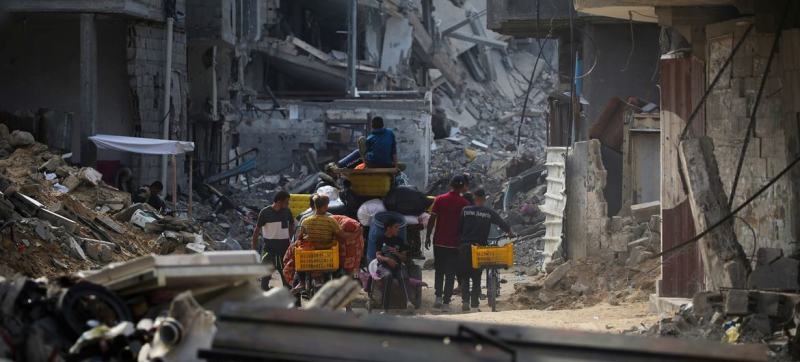- CA Yunus pays homage to Liberation War martyrs on Victory Day |
- Bangladesh capital market extends losing streak for second day |
- Bangladesh celebrates Victory Day Tuesday |
- 'Different govts presented history based on their own ideologies': JU VC |
An aid worker’s journey through ‘hell’ - shattered Gaza

People search for water in Khan Younis city in the southern the Gaza Strip. (file) © UNICEF-Eyad El Baba
22 hours 17 minutes ago - Over and above the difficulty of actually getting into Gaza, aid teams now face the crushing realization that with a shortage of fuel and dwindling supplies, there is a limit to what they can do to help all those in need, UN aid worker Louise Wateridge told UN News on Friday.
“You can hear bombardments from the north, the middle and the south…Gaza now really is hell on earth, It’s very hot…Trash is piling up everywhere, people living under plastic sheeting where temperatures soar,” said Ms. Wateridge, a Senior Communications Officer with the UN agency for Palestinian refugees, UNRWA, hours after returning to the shattered enclave since Hamas-led terror attacks and hostage-taking last October sparked the war.
After arriving on Thursday through the Kerem Shalom crossing in southernmost Gaza, Ms. Wateridge said that what she saw of nearby Rafah was “destroyed”. The city had been her base during her first tour in May, when Israeli forces seized the key border crossing, further hampering aid deliveries into Gaza.
The desolate scene was repeated on the aid worker’s journey north to central Gaza, where she is now based.
Empty shells of houses for shelters
“The drive through Khan Younis was shocking - I hadn’t been there since before 6 May invasion of Rafah and it was a ghost town because everything is destroyed."
“Now, there are many, many families living inside these destroyed skeleton buildings. Blankets or plastic sheeting has been put up where walls have been blown out. So it’s very visible to see the difference that the Rafah invasion and ongoing military action has had.”
Lawlessness and looting
The UNRWA worker confirmed reports of a breakdown in law and order after nearly nine months of intense Israeli bombardment that have upended normal life in Gaza and left people resorting to stopping aid trucks in search of food once they cross into Gaza through Kerem Shalom.
“The road was full of looters when we arrived. We arrived at the same time as some aid trucks, and so there were hundreds of armed men awaiting their arrival. The trucks we passed on the way were very destroyed - windscreens completely smashed, they all have metal bars reinforcing the driver’s area. It felt totally lawless.”
‘Every single’ UN building damaged or destroyed
Deeper into Gaza, Ms. Wateridge described the damage inflicted on UN facilities en route from Kerem Shalom to Khan Younis, Deir al Balah and beyond, with some pockmarked with large holes from shelling and others gutted, open to the elements.
“Every single UNWRA facility - school, warehouse, food distribution etc - was significantly damaged or even destroyed. Bullet holes, walls blown out, floors collapsed like pancakes on top of each other - you would have no idea that these were UN facilities protected by international law.”
According to the UN aid coordination office, (OCHA), since the beginning of 2024, only 14 per cent of fuel (diesel and benzene) that used to enter Gaza on a monthly basis prior to October 2023, has been allowed into the enclave (two million litres compared with 14 million litres).
“We have no fuel so we cannot go anywhere - all humanitarians,” said Ms. Wateridge, confirming that aid operations continue to be hampered by the difficulty of retrieving fuel from Kerem Shalom. “For UNRWA, there are plans to distribute what we have - food and mattresses - but it’s very limited. It’s another testament to how bad it is for humanitarian response, when we do not even have enough fuel to move ourselves.”
In addition to these challenges, UNRWA workers face their own problems, Ms. Wateridge explained. “I’m looking forward to seeing them; they’re okay, but they’re very traumatised from being displaced from Rafah. They also have nothing left now.” – UN News.

